Explore 28 Types of Goldfish for Your Aquarium | Goldfish Varieties
Goldfish bring vibrant beauty to your aquarium.
Are you considering adding a variety of goldfish to a new aquarium in your home? With over 100 different species of goldfish, there's a wide selection to choose from. Keep in mind that some species require more space than others, and goldfish generally live for 5 to 10 years. Therefore, ensure you have a suitably sized tank and are ready for the long-term commitment.
Here are 28 types of goldfish you might want to consider for your aquarium.
How To Take Care Of Goldfish
All fish need a spacious tank equipped with a good filtration system. Never house your fish in a bowl, regardless of the species! Goldfish are temperate fish that don't need a heater, but they thrive in a large aquarium with plenty of room to swim and other goldfish for company.
When selecting decor items, make sure they won't trap or injure your fish. Goldfish with long bodies and without protruding eyes or double fins are well-suited for outdoor ponds and can coexist with koi. Additionally, providing a mix of live plants can enhance the aquarium environment, offering both aesthetic appeal and natural filtration.
Regardless of the type of fish you're adding to a tank or pond, it's important to quarantine new additions to prevent the spread of diseases to your existing aquarium. Regular maintenance, such as water changes and monitoring water quality, is crucial to ensure a healthy environment for your goldfish.
Fantail
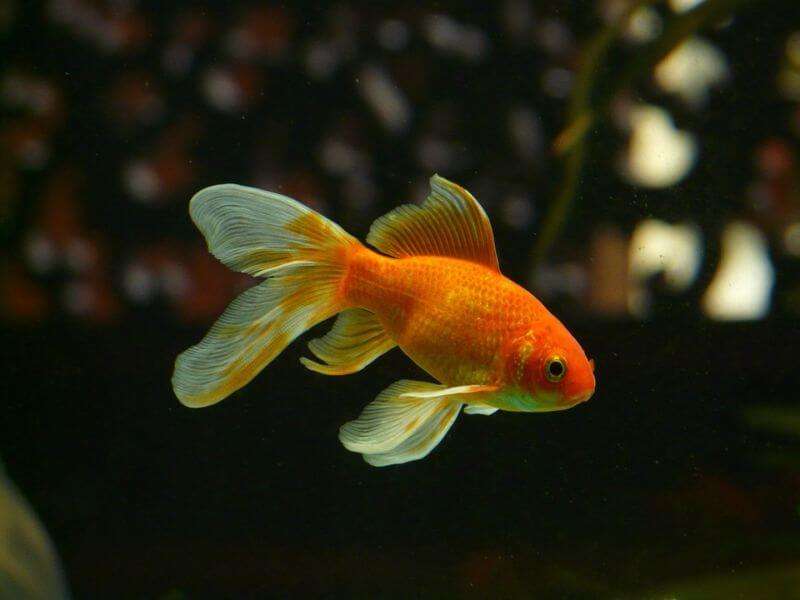
The fantail goldfish is a fancy breed known for its distinctive double tail, which is fused along the dorsal edge. This breed has a medium to short body, which can cause some swimming challenges.
Fantails should be kept indoors in a tank of at least 20 gallons, as swimming outdoors would be too strenuous for them. Their slow swimming speed makes it difficult for them to compete for food with faster fish and makes them vulnerable to predators in outdoor ponds.
Size: 7 inches
Lifespan: 12 years
Distinctive Traits: Medium-sized goldfish with a double tail fin and a range of colors
Ryukin
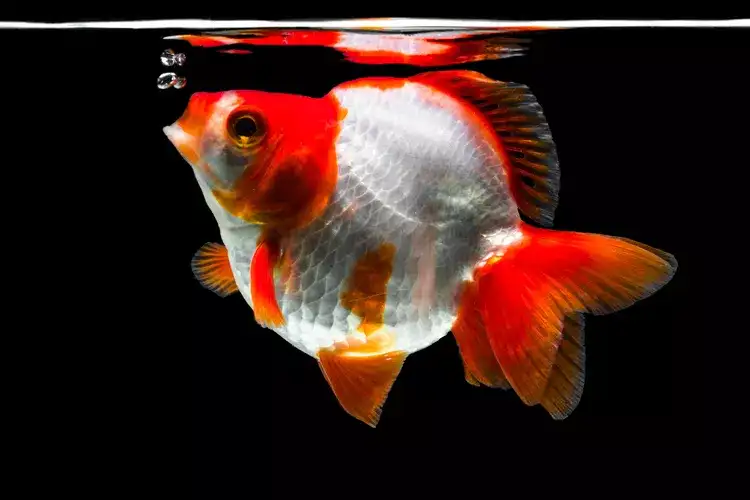
Ryukin goldfish are recognized by their extremely short bodies and the distinctive hump located behind their heads. This variety is available in red, black, white, or a mix of these colors. Due to their poor swimming abilities, they can be kept in smaller aquariums (10 gallons per fish) to accommodate their limited movement. Poor swimmers like Ryukins often require more frequent feeding to compensate for their high caloric expenditure from the effort of swimming.
Size: 4 inches
Lifespan: 10 years
Distinctive Traits: Short-bodied goldfish with a hump behind the head, short fins, and various colorations
Dorsqal Fin
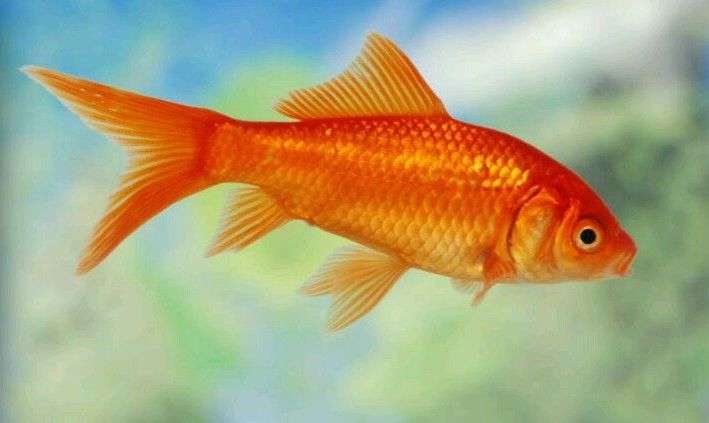
Dorsal fin goldfish are easily identified by the prominent fin on their back. This fin helps them maintain stability and maneuverability in the water. These goldfish come in various colors and patterns, making them a popular choice among aquarium enthusiasts. They generally have a streamlined body, which aids in better swimming compared to some other varieties.
Length: 6 inches
Lifespan: 10-15 years
Distinctive Traits: Streamlined body with a prominent dorsal fin, available in various colors and patterns
Veil Tail
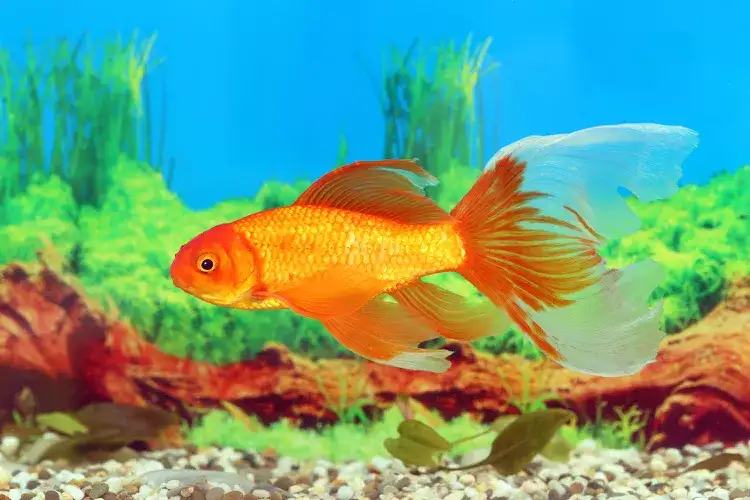
The veiltail goldfish, a variant of the fantail, showcases an elongated tail fin that can appear across various goldfish breeds. This type also typically features extended fins on other parts of its body, including the pectoral, dorsal, anal, and pelvic fins.
It's crucial to house veiltails with peaceful tankmates to prevent damage to their delicate, long fins. Aggressive species like African cichlids and certain barbs should be avoided. Additionally, the aquarium should contain soft decorations such as smooth objects and plants. A tank size of at least 30 gallons is recommended to provide ample space.
Length: 8 inches (notably long tail!)
Lifespan: 8 years
Distinctive Traits: Medium to short-bodied goldfish with elongated fins throughout the
Curled Gill
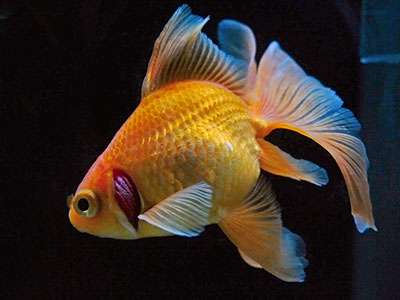
Curled Gill goldfish are distinguished by their unique curled gill covers, which give them a distinct appearance. This variety can come in various colors and patterns, adding to their visual appeal. They typically have a streamlined body shape, aiding in their swimming ability.
Length: 5 inches
Lifespan: 10-15 years
Distinctive Traits: Streamlined body with curled gill covers, available in various colors and patterns
Tosakin
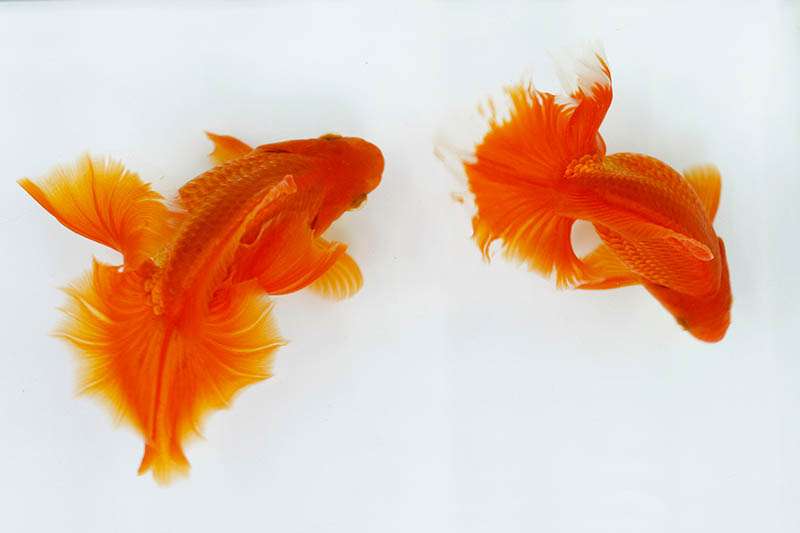
Tosakin goldfish are distinguished by their unique double-tail fin configuration, which gives them a distinct appearance. This variety can come in various colors including red, white, orange, black, and calico patterns, enhancing their visual appeal. They typically have a compact body shape with a slightly rounded form, complementing their ornate tail structure.
Length: 6-8 inches
Lifespan: 10-15 years
Distinctive Traits: Medium-sized goldfish with a distinctive double-tail fin, available in various colors and patterns
Butterfly
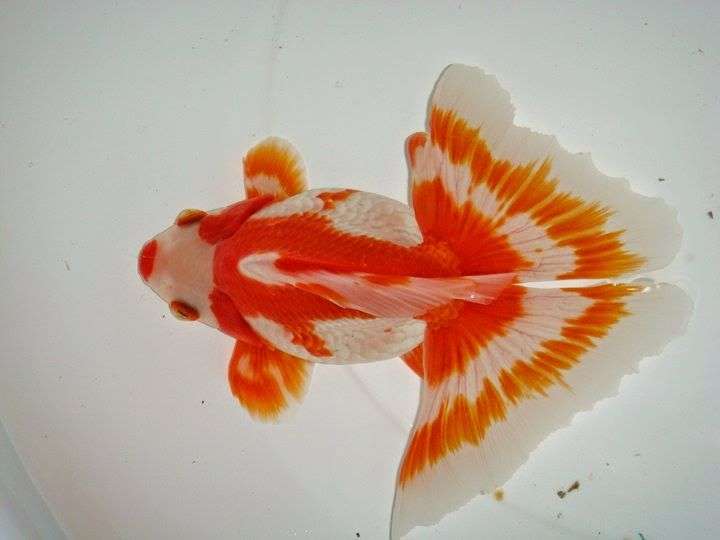
Butterfly goldfish, also known as butterfly tail or butterfly fin goldfish, are characterized by their elongated and gracefully spread tail fins that resemble butterfly wings. This variety can appear in different goldfish types, such as Ryukin, Fantail, or Telescope, with the defining feature being their uniquely shaped fins. The tail fin extends horizontally and is split into two lobes, giving it a butterfly-like appearance.
Length: 6-8 inches
Lifespan: 10-15 years
Distinctive Traits: Medium-sized goldfish with elongated and horizontally spread butterfly tail fins, available in various colors and goldfish varieties
Phoneix
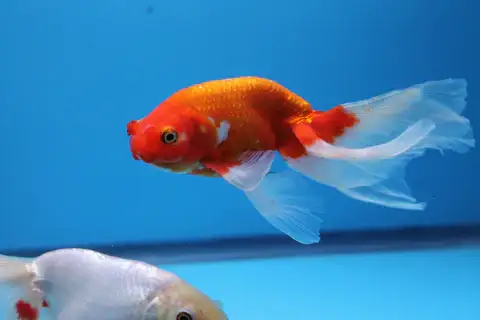
Phoenix goldfish, also known as Japanese Jikin, are characterized by their slender body and distinctive forked tail fins that resemble the spread tail of a phoenix bird in flight. This variety is highly prized for its ornamental appearance and graceful swimming style. Phoenix goldfish are available in a variety of colors, typically with metallic or pearlescent scales that shimmer under light, adding to their visual appeal.
Length: 6-8 inches
Lifespan: 10-15 years
Distinctive Traits: Slender body with distinctive forked tail fins resembling the spread tail of a phoenix bird, available in various metallic or pearlescent colors
Bubble Eye
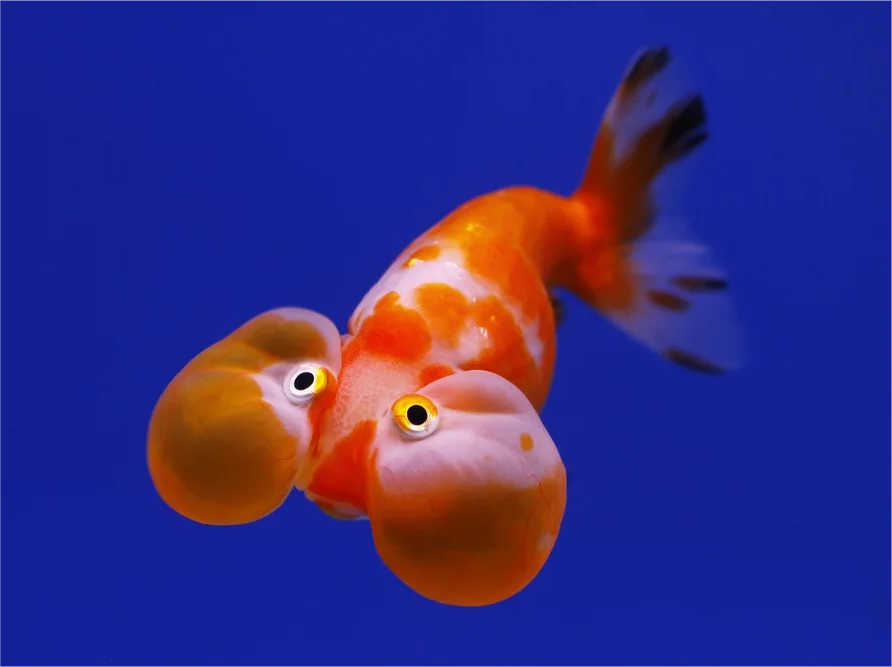
The Bubble Eye Goldfish is known for its distinctive appearance, featuring enlarged fluid-filled sacs under each eye, similar to Moor goldfish but more pronounced. These sacs are filled with buoyant fluid, posing no buoyancy issues. Careful tank decor is essential to prevent injuries to these vulnerable areas, with a minimum tank size of 20 gallons recommended. Peaceful tank mates are advisable due to their susceptibility to eye injuries. They typically reach 5 inches in length and live about 8 years, thriving in stable water conditions with diligent care.
Length: 5 inches
Lifespan: 8 years
Distinctive Traits: Medium to short-bodied goldfish, ventral conjunctival protrusions bilaterally
Celestial Eye
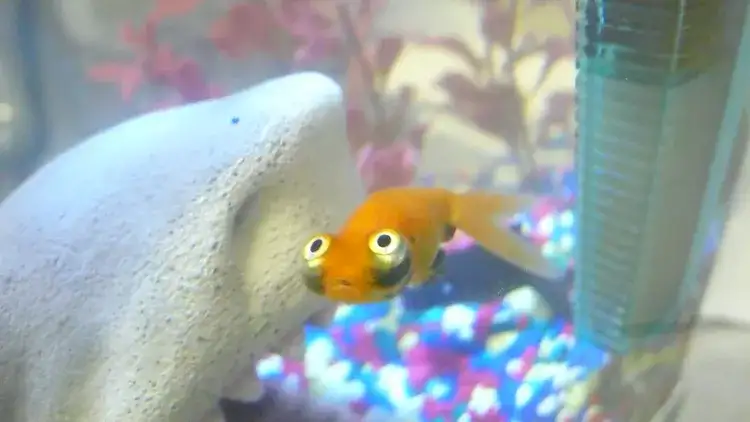
The Celestial Eye Goldfish is similar to the telescope and bubble eye varieties, known for its upward-facing protruding eyes. These fish require extra time to eat and should be housed in aquariums with a minimum size of 10 gallons per fish. Decorations should be placed low to prevent collisions, and tank mates should be peaceful to avoid damaging their protruding eyes. Smooth and soft decor, free of rough edges, is recommended to ensure their well-being and comfort in the aquarium.
Length: 4 inches
Lifespan: 6 years
Distinctive Traits: Medium to short-bodied goldfish, eyes extended from body and position dorsally
Black Moor
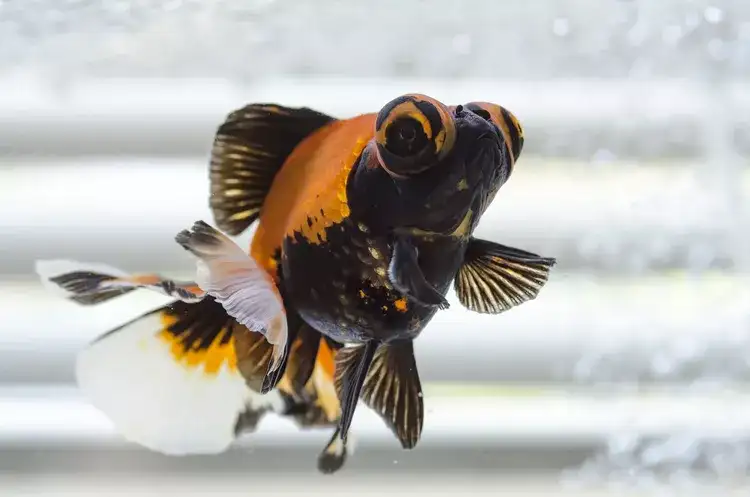
The Black also called Telescope Eye goldfish, are known for their short bodies and protruding eyeballs, which give them a distinctive appearance. Due to poor eyesight, they eat slower and are prone to eye injuries. It's crucial to select tank decor carefully, opting for smooth items without sharp edges to prevent damage to their delicate eyes. They require a minimum tank size of 20 gallons to thrive comfortably.
Length: 7 inches
Lifespan: 8 years
Distinctive Traits: Short-bodied goldfish, bilaterally protruding eye globes, red or black or mixed coloration
Telescope Panda
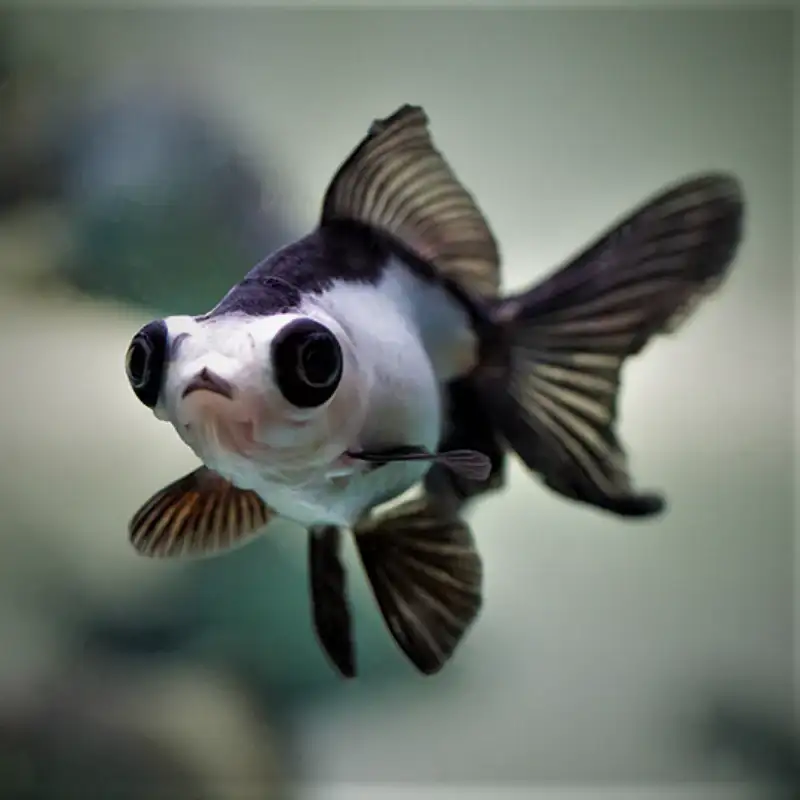
Telescope Panda Goldfish, like the Celestial Eye and Bubble Eye varieties, are characterized by their protruding eyes that face upwards. These fish require additional time to feed and should be housed in tanks with a minimum size of 10 gallons per fish. Decorations should be positioned low to prevent collisions, and tank mates should be peaceful to avoid injuring their prominent eyes. Optimal tank decor includes smooth and soft items without rough edges to ensure their comfort and well-being in the aquarium.
Length: 4 inches
Lifespan: 6 years
Distinctive Traits: Medium to short-bodied goldfish with protruding eyes, typically black and white in color like a panda
Sabao
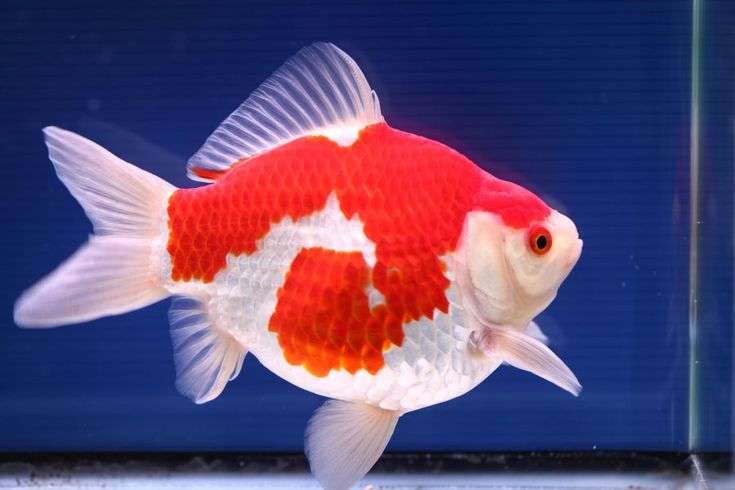
Sabao Goldfish are highly valued for their beauty and graceful swimming style. Providing them with a spacious and well-maintained environment, suitable tank decor, and compatible tank mates ensures they thrive and display their stunning colors and elegant fins to their fullest potential in aquarium settings.
Length: 4 to 6 inches
Lifespan: 6 years
Distinctive Traits: Medium to short-bodied goldfish with vibrant coloration, often featuring red, white, orange, and black markings
Wakin
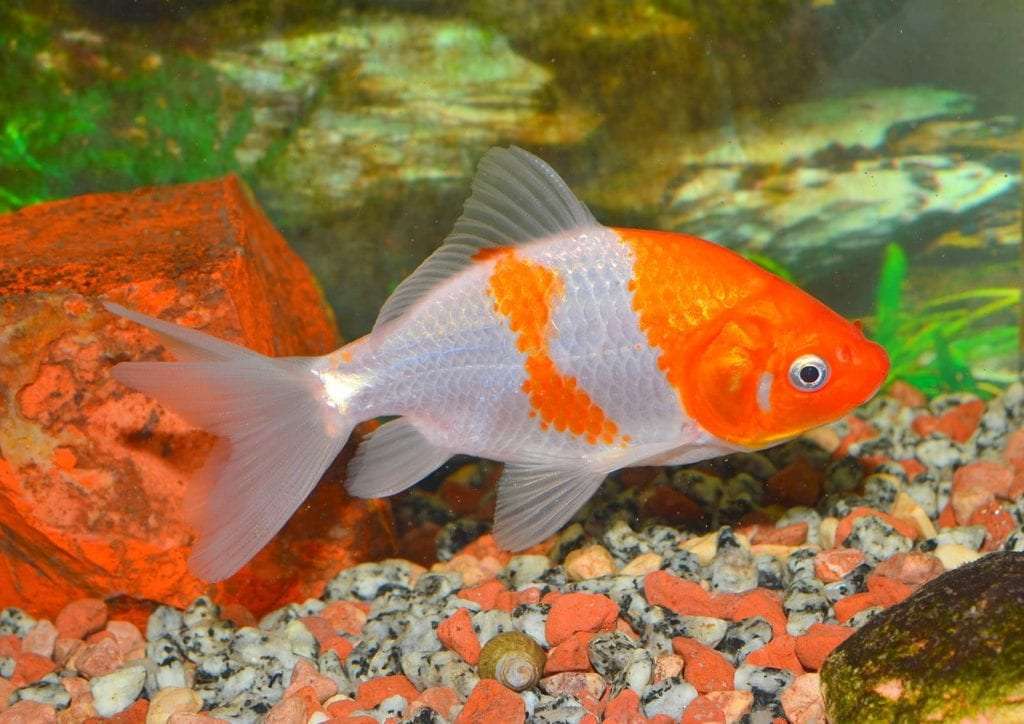
Wakin Goldfish are prized for their streamlined bodies and vibrant colors, with a slender, elongated form and a distinctive double tail fin resembling a longer, narrower fantail. They thrive in spacious aquariums with smooth, soft decor to prevent injury to their delicate fins. Peaceful and preferring well-filtered water between 65°F to 75°F, they can live up to 15 years with proper care, making them a cherished choice for fish enthusiasts seeking beauty and tranquility in their aquariums.
Length: 6 to 10 inches
Lifespan: 15 years
Distinctive Traits: Medium to long-bodied goldfish with a double tail fin resembling a fantail but longer and narrower.
Watonai
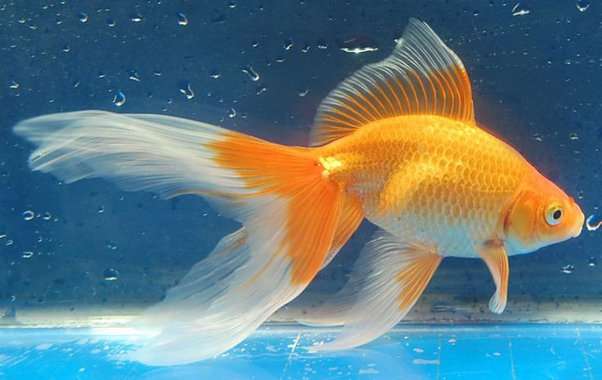
Watonai Goldfish are prized for their graceful appearance and peaceful demeanor. By providing them with a spacious and well-maintained aquarium, suitable tank decor, and compatible tank mates, aquarists can ensure these goldfish thrive and display their stunning colors and elegant fins to their fullest potential.
Length: 6 to 10 inches
Lifespan: 10 years or more
Distinctive Traits: Medium to long-bodied goldfish with a double tail fin resembling a fantail but longer and more flowing.
Jikin
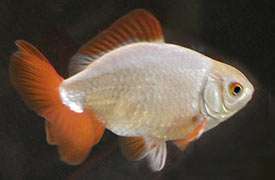
Jikin Goldfish, also known as "Peacock Tail" Goldfish, are prized for their slender body, unique tail resembling a peacock's fan with four lobes, and metallic scales in red, white, and black. They thrive in spacious aquariums with smooth decor, preferring well-filtered water between 65°F to 75°F. Peaceful but shy, they require calm tank mates and can live up to 10 years with proper care, making them a captivating choice for fish enthusiasts.
Length: 6 to 8 inches
Lifespan: 10 years
Distinctive Traits: Medium-sized goldfish with a unique tail resembling a peacock's tail.
Perscale
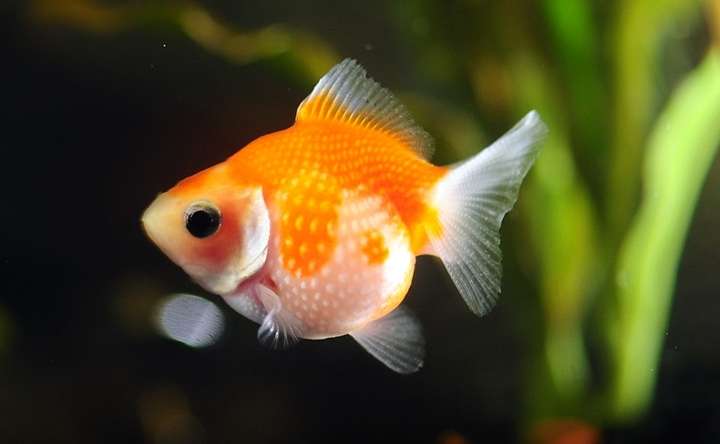
Pearlscale Goldfish are known for their rounded bodies and unique, pearl-like raised scales. Available in orange, red, white, and calico, they have a spherical shape and a double tail fin. They need spacious aquariums of at least 20 gallons per fish, well-filtered water at 65°F to 75°F, and regular water changes. Due to their delicate nature, a high-fiber diet and smooth, soft tank decor are essential. Peaceful and best kept with other calm goldfish varieties, Pearlscales can live up to 10-15 years with proper care.
Length: 5 to 7 inches
Lifespan: 10-15 years
Distinctive Traits: Medium-sized goldfish with a spherical body shape and unique, pearl-like raised scales.
Demikin
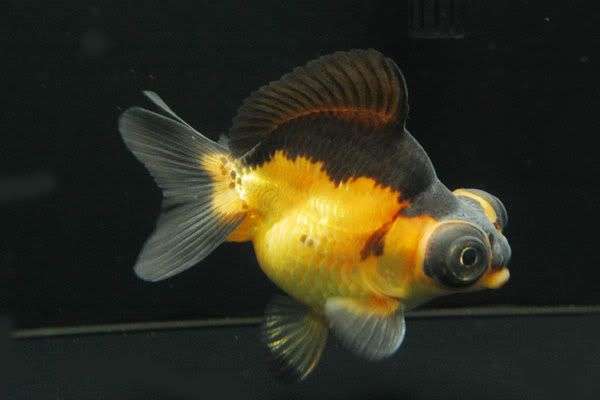
Demekin Goldfish, also known as Telescope Goldfish, have distinctive protruding eyes and a rounded body with long, flowing fins. They come in various colors like red, orange, black, and calico. They need spacious tanks of at least 20 gallons, well-filtered water at 65°F to 75°F, and regular water changes. Smooth tank decor is crucial to prevent eye injuries. Peaceful by nature, they thrive with other calm goldfish varieties. With proper care, they can live up to 10-15 years.
Length: 6 to 8 inches
Lifespan: 10-15 years
Distinctive Traits: Medium to large-sized goldfish with a rounded, egg-shaped body and distinctive protruding eyes.
Oranda
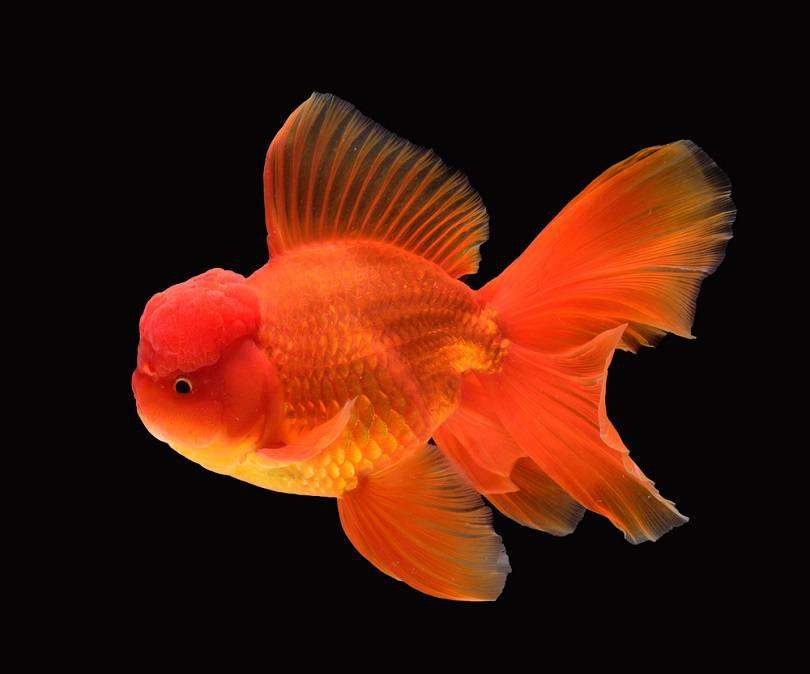
Oranda Goldfish feature a double tail similar to the Fantail Goldfish but are distinguished by the wen on top of their heads. This is a benign skin growth that can become excessive due to poor diet or genetic issues. A 30-gallon tank is necessary to provide adequate space for these fish.
If the wen overgrows, it must be trimmed by a veterinarian. Attempting to trim it yourself can cause significant harm to their delicate eye tissue and may result in blindness.
Length: 6 inches
Lifespan: 12 years
Distinctive Traits: Medium to short-bodied goldfish, wen on top of head, variable colors
Izumo
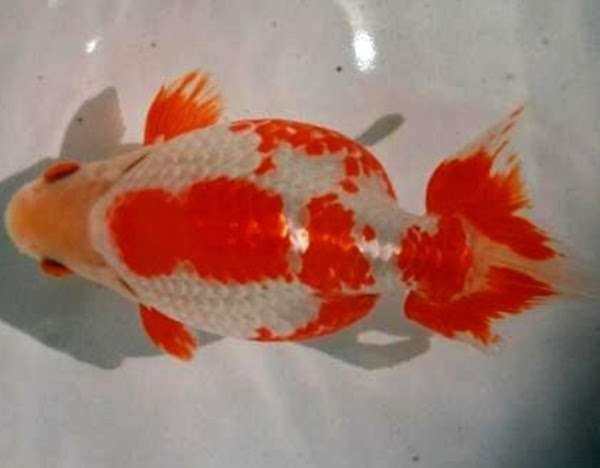
Izumo Goldfish have a streamlined, elongated body with a double tail fin and vibrant coloration, including red, white, and various patterns. They need at least 20 gallons per fish, well-filtered water at 65°F to 75°F, and regular water changes. Smooth and soft tank decor is essential to prevent injuries. Peaceful and compatible with other calm goldfish varieties, Izumo Goldfish can live up to 10-15 years with proper care.
Length: 6-8 inches
Lifespan: 10-15 years
Distinctive Traits: Medium to large-sized goldfish with a streamlined, elongated body and a double tail fin.
Pom Pom
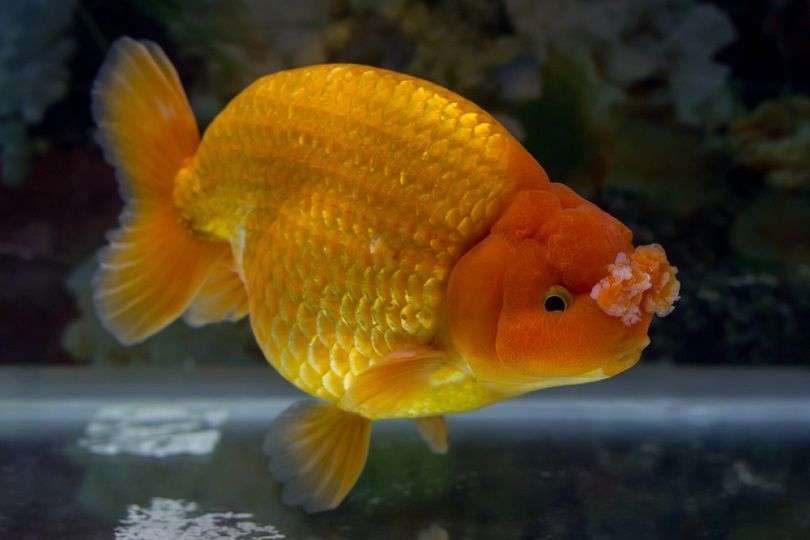
Pom Pom Goldfish are notable for their nasal outgrowths resembling fluffy pom-poms and their rounded bodies with long, flowing fins. They come in various colors, including red, orange, white, black, and calico. They need at least 20 gallons per fish, well-filtered water at 65°F to 75°F, and regular water changes. Smooth and soft tank decor is essential to prevent injuries. They are peaceful and compatible with other calm goldfish varieties, and they can live up to 10-15 years with proper care.
Length: 6-8 inches
Lifespan: 10-15 years
Distinctive Traits: Medium to large-sized goldfish with a streamlined, elongated body and a double tail fin.
Lion Head
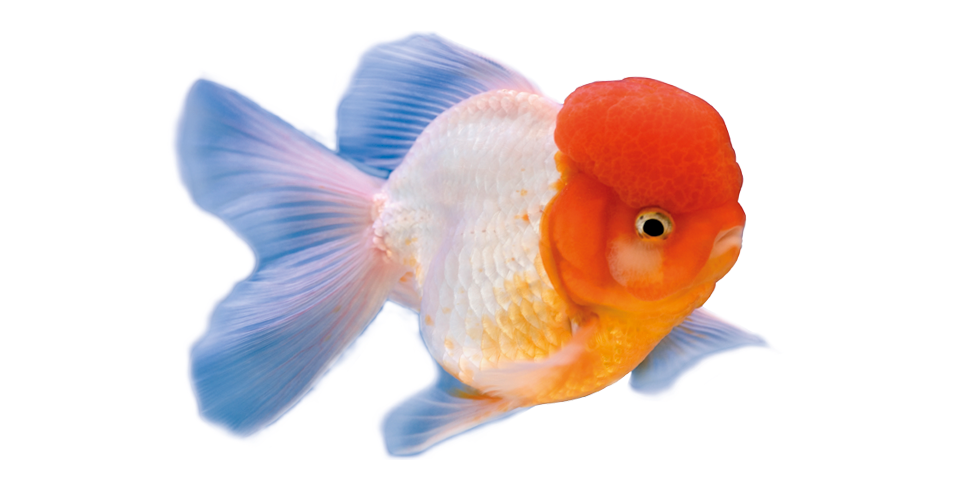
The Lionhead Goldfish, a fancy variety akin to the Ranchu, is distinguished by its double caudal fins, prominent wen growth on the head and face which can sometimes obstruct vision, and chubby cheeks. There is also a rarer type with longer fins. These fish should be housed with peaceful tank mates that are not overly fast, as Lionheads are poor swimmers and may struggle to compete for food. Each fish requires a minimum of 20 gallons of tank space to thrive. It's important to monitor the growth of their wen to ensure it does not impede their sight, and to provide a suitable environment with gentle tank mates to avoid stress and injury.
Length: 6 inches
Lifespan: 10 years
Distinctive Traits: Short-bodied goldfish, no dorsal fin, wen on face and top of head
Ranchu
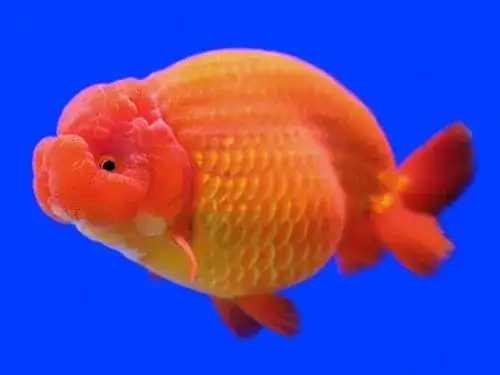
Ranchu goldfish are characterized by their compact, hunched bodies and the absence of a dorsal fin. Their tail peduncle is downturned, which limits their ability to swim over long distances, making smaller tanks of around 20-30 gallons ideal for their care. Some Ranchu may exhibit a partial wen growth on the head, cheeks, or operculum (gill cover). The absence of a dorsal fin further complicates their swimming capabilities. It's crucial to choose tank mates that are calm and not overly fast-moving, as Ranchu are not strong swimmers and may struggle to compete for food in a tank environment.
Length: 6 inches
Lifespan: 8 years
Distinctive Traits: Short-bodied goldfish, no dorsal fin, wen may or may not be present on face
Panda Moor
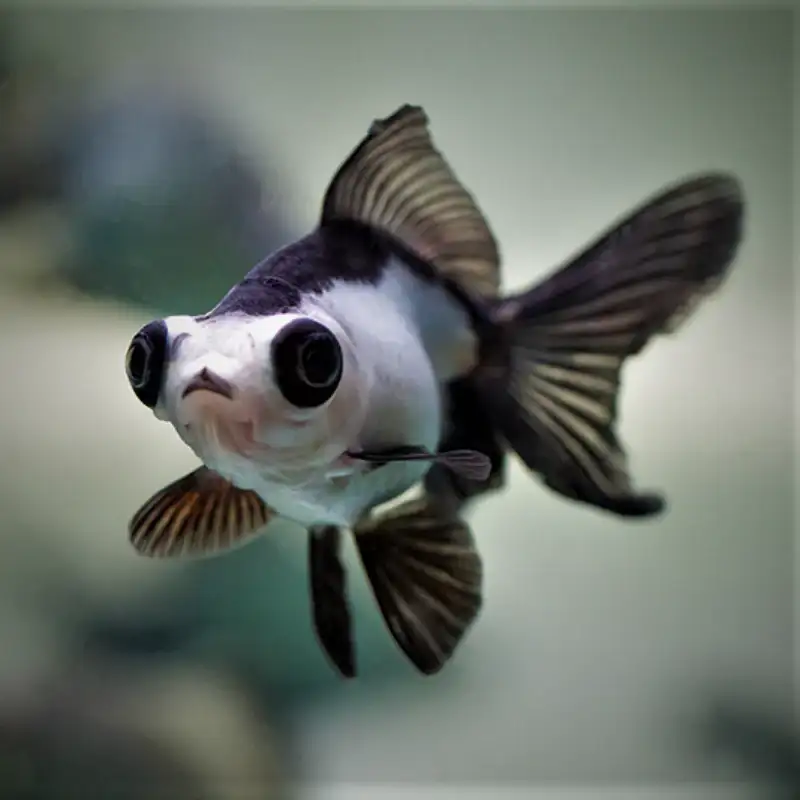
Panda Moor Goldfish are medium-sized with a rounded body, protruding eyes, and a distinctive black and white coloration. They need at least 20 gallons per fish, well-filtered water at 65°F to 75°F, and smooth tank decor to prevent injuries. Peaceful and compatible with other calm goldfish varieties, Panda Moor Goldfish can live up to 10-15 years with proper care.
Length: 4-5 inches
Lifespan: 10-15 years
Distinctive Traits: Medium-sized goldfish with a rounded body, protruding eyes, and a striking black and white coloration reminiscent of a panda bear.
Red Cap Oranda
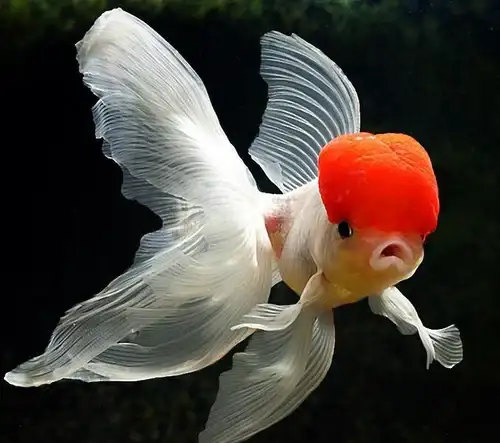
Red Cap Oranda Goldfish are medium-sized with a rounded body, double-tail fins, and a prominent red growth on their heads. They require at least 20 gallons per fish, well-filtered water at 65°F to 75°F, and smooth tank decor to prevent injuries. Peaceful and compatible with other calm goldfish varieties, Red Cap Orandas can live up to 10-15 years with proper care.
Length: 6-8 inches
Lifespan: 10-15 years
Distinctive Traits: Medium-sized goldfish with a rounded body, double-tail fins, and prominent red growth
Brass Goldfish
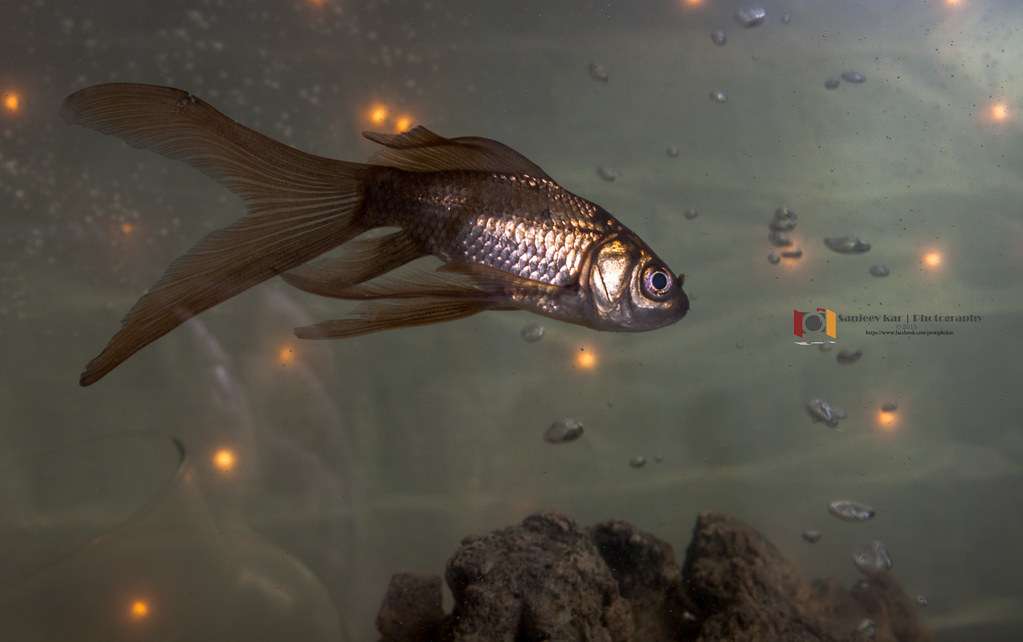
Brass Telescope Goldfish are medium-sized with a rounded body, protruding telescope eyes, and a metallic gold or brass coloration. They require at least 20 gallons per fish, well-filtered water at 65°F to 75°F, and smooth tank decor to prevent injuries. Peaceful and compatible with other calm goldfish varieties, Brass Telescope Goldfish can live up to 10-15 years with proper care.
Length: 6-8 inches
Lifespan: 10-15 years
Distinctive Traits: Medium-sized goldfish with a rounded body, double tail fin
Albino
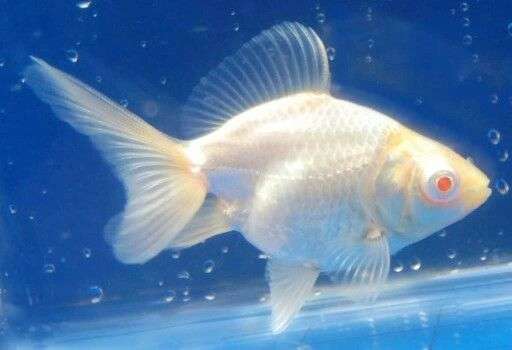
Albino Goldfish are medium-sized with a white or pale pink body coloration and red or pink eyes. They require at least 20 gallons per fish, well-filtered water at 65°F to 75°F, and smooth tank decor to prevent injuries. Peaceful and compatible with other calm goldfish varieties, Albino Goldfish can live up to 10-15 years with proper care.
Length: 6-8 inches
Lifespan: 10-15 years
Distinctive Traits: Medium-sized goldfish with a white or pale pink coloration due to lack of pigmentation
Sarasa Goldfish
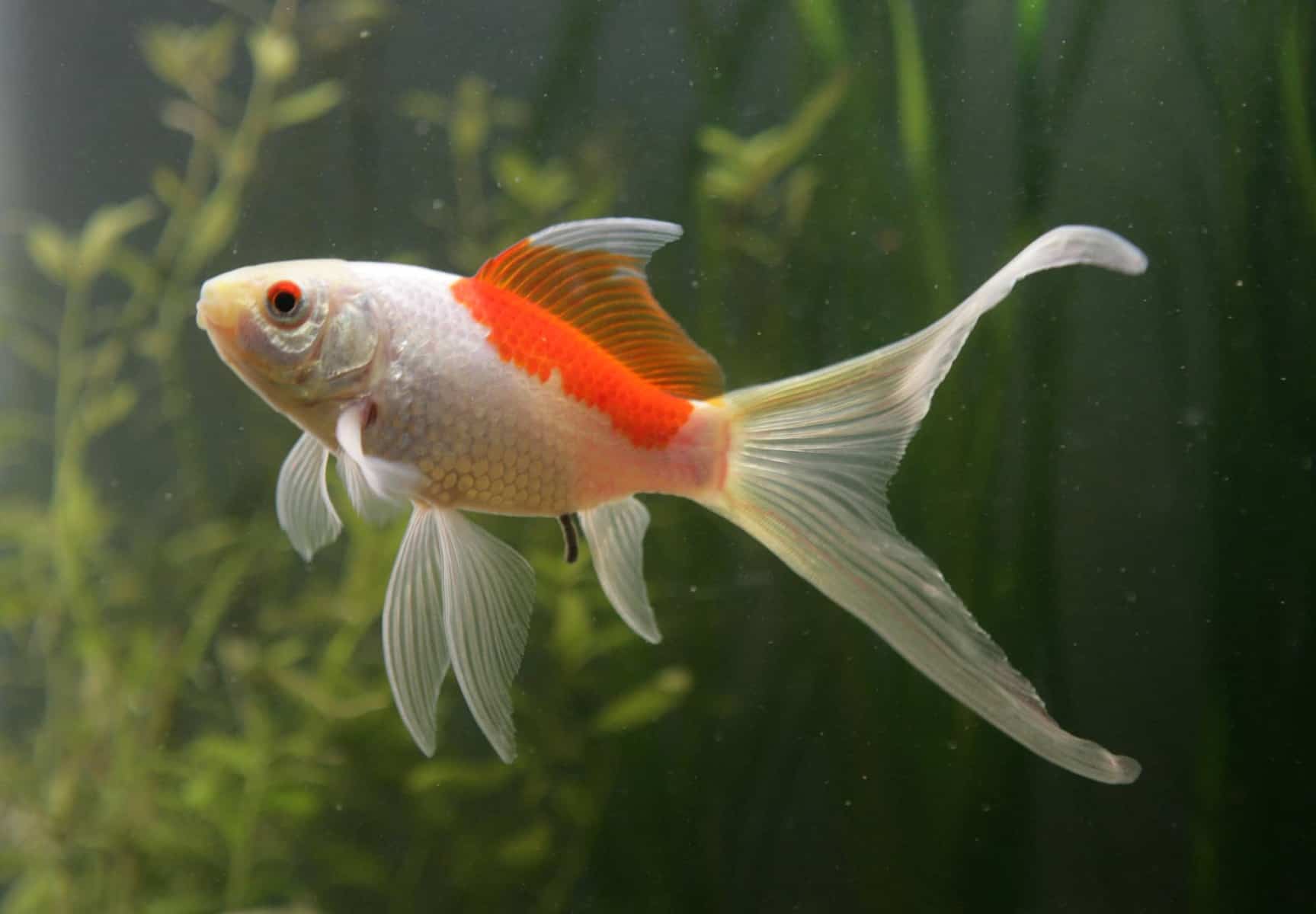
Often referred to as "painted goldfish," Sarasa goldfish bear a striking resemblance to kohaku koi, adorned with vivid red and white patterns. These fish boast elongated bodies and fins, making them suitable for both indoor aquariums and outdoor aquatic environments. Providing them with ample space, such as a 50-gallon tank, ensures their comfort and well-being.
Length: 12 to 14 inches
Lifespan: 20 years
Distinctive Traits: Long-bodied goldfish, red and white color only
Conclusion
Choosing the right type of goldfish for your aquarium involves considering various factors such as tank size, compatibility with other fish, and specific care requirements. Each variety, from the Fantail and Ryukin to the Oranda and Sarasa, offers unique characteristics in terms of body shape, fin type, and coloration. Ensuring a spacious environment with proper filtration, suitable tank decor, and compatible tank mates is essential for their well-being. Goldfish, like the Sarasa with its vibrant red and white patterns or the Oranda with its distinctive wen growth, can thrive in both indoor aquariums and outdoor ponds if provided with adequate space and care. Regular maintenance and monitoring of water quality are crucial for their longevity, with some varieties like the Sarasa potentially living up to 20 years or more. Ultimately, choosing the right goldfish involves understanding their individual needs and providing a suitable environment to showcase their beauty and ensure their health.















